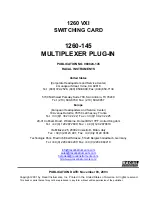
8
The Maximum terminal voltage drop is 250mV except for the
10A range
.
Note: If
connected incorrectly with the voltage at these
ranges, quickly remove the test leads from the circuit as to
avoid damage to this tester.
(This tester can afford the voltage <250V DC/AC rms. for the
period of 5 seconds max.)
Resistance Measurement
WARNING: DO NOT APPLY VOLTAGE TO MEASURING
TERMINAL WHILE RANGE SWITCH IS IN OHM POSITION
.
1. Set the selector switch to the appropriate
Ω
range to be used.
2. Connect the BLACK test lead to the “-COM” jack and the RED
test lead to the Red “+” jack.
3. Short the leads by touching the probes together. Pointer should
read zero at the right hand end of the upper most scale, if it
doesn’t, use the Ohm adjust knob on the right hand of the panel
to line up the pointer with zero. (If pointer can’t be brought to
zero, replace battery.)
4. Connect the test leads across the resistance to be measured.
5. Take reading on the top “
Ω
” scale and multiply it by the
multiplication factor indicated by the selector switch.
6. If there is little or no pointer movement from the left side of the
scale, reset the selector switch to higher range. The effective
reading scope on an Ohm meter scale is within the area of
between 25 degree of Arc left side to the Midscale and 25
degree right side to the Midscale.
Note: If connected incorrectly with the voltage, quickly
remove the test leads from the circuit as to avoid damage to
this tester. (This tester can afford the voltage <250V DC/AC
rms. for the period of 5 seconds max.)
9
Diode Measurement
1. Set the selector switch to the appropriate
Ω
range to be used.
NOTE: To test the diode while current below 0.060 mA at X 10K
range; current below 0.15 mA at X 1K range; current below 1.5
mA at X 100 range; current below 15 mA at X 10 range; current
below 150 mA at X 1 range.
2.
For IF (forward current) test
, put the BLACK test lead to the
“-COM” jack and the RED test lead to the Red “+” jack. And
then connect the Black probe to the Positive terminal of the
Diode, the Red probe to the Negative terminal of the Diode.
For IR (reverse current) test
, reverse the connection.
3. Read the value IF or IR of the diode on the LI scale.
4. Read the linear (forward voltage) VF of the diode on the LV
scale.
Continuity Test
WARNING: DO NOT APPLY VOLTAGE TO MEASURING
TERMINAL WHILE RANGE SWITCH IS IN OHM POSITION
.
Set the selector switch to the BUZZ range. Connect the test leads
to two points of circuit. If the resistance is lower than 200 Ohm
approx., the Beeper sounds.
Note: Battery voltage is sufficient for Buzzer operation as long as
the Zero Ohm pointer can be adjusted to the Zero scale place.
Note: If connected incorrectly with the voltage, quickly
remove the test leads from the circuit as to avoid damage to
this tester..
(This tester can afford the voltage <250V DC/AC rms. for the
period of 5 seconds max.)
10
Transistor hFE and LED Test
1. Set the selector switch to the R X 10 range.
FOR Measuring Transistor hFE
2. Take note the type of transistor “PNP” or “NPN” and then insert
the transistor terminals of the Emitter, Base and Collector
separately into the proper holes of the socket on the front panel.
3. Read the approximate hFE Value directly at the hFE scale.
Note: Current 10
μ
A. VCE 2.8V.
4. When the Base terminal cut, the value of Leak is Iceo for
Transistor.
FOR Measuring LED: Insert the transistor terminals directly into
the “
+
” and “
-
” holes of the socket on the front panel.
And then check if the LED under testing is lighting.
Battery Check
1. This meter can come with two separate battery check ranges to
test either DC 1.5V or 9V batteries.
2. Set the selector switch to the appropriate BATT range to be
used.
3. Connect the BLACK test lead to the “-COM” jack and the RED
test lead to the Red “+” jack.
4. Connect the Red test lead to the positive end of battery and the
Black one to the negative end of the battery to be measured.
5. Take reading on the “BATT” scale and check it good or bad as
per which portion indicated.
(Note: the mark section of “?” shows that the battery may be
starting to decay.)
Note: If connected incorrectly with the voltage, quickly
remove the test leads from the circuit and can avoid the
damage to this tester.
(This tester can afford the voltage <250V DC/AC rms. for the
period of 5 seconds max.)
11
Decibels Measurement
1.
Set the selector switch to AC 10V range.
2.
Connect the BLACK test lead to the “-COM” jack and the
RED test lead to the Red “+” jack.
3.
Connect the test leads to the measuring circuit specially in
series with a 0.047
μ
F/400V Metalized Polyester Capacitor.
And then read the bottom Red dB scale.
4.
For more dB scope, change the selector switch to the others
of ACV ranges and make the same actions. Add the
appropriate number of dB scale reading as noted on the
chart below.
NOTE: For absolute dB measurements, circuit impedance
must be 600 Ohm. 0 dB = 1mw dissipated in a 600 Ohm
impedance (equivalent to 0.755V across 600 Ohm)
ACV RANGE
ADD dB Number
50 14
250 28
1000 40
Capacitance Measurement with the
optional accessory kit of
Item no. MT2007-C
WARNING: DO NOT APPLY VOLTAGE TO MEASURING
TERMINAL WHILE MAKING ANY CAPACITANCE
MEASUREMENTS
.
BEFORE TESTING ANY CAPACITORS, DISCHARGE THE
CAPACITOR COMPLETELY.
BEFORE MEASUREMENTS, PLEASE READ THE
INSTRUCTIONS OF MT2007-C CAREFULLY.
























